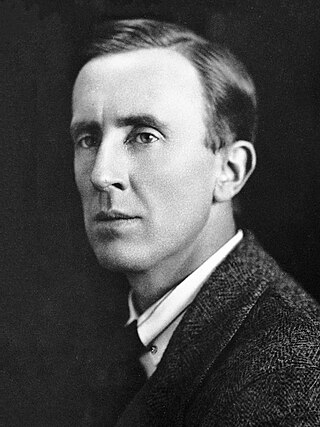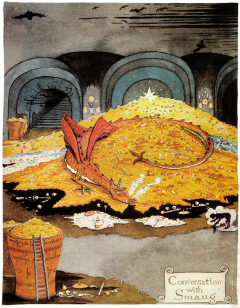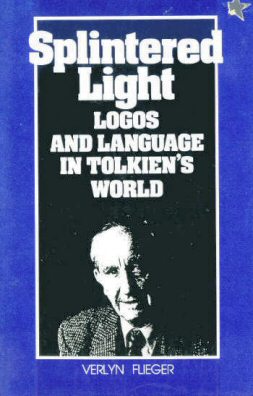Related Research Articles

John Ronald Reuel Tolkien was an English writer and philologist. He was the author of the high fantasy works The Hobbit and The Lord of the Rings.

Smaug is a dragon and the main antagonist in J. R. R. Tolkien's 1937 novel The Hobbit, his treasure and the mountain he lives in being the goal of the quest. Powerful and fearsome, he invaded the Dwarf kingdom of Erebor 171 years prior to the events described in the novel. A group of thirteen dwarves mounted a quest to take the kingdom back, aided by the wizard Gandalf and the hobbit Bilbo Baggins. In The Hobbit, Thorin describes Smaug as "a most specially greedy, strong and wicked worm".
Layamon or Laghamon – spelled Laȝamon or Laȝamonn in his time, occasionally written Lawman – was an English poet of the late 12th/early 13th century and author of the Brut, a notable work that was the first to present the legends of Arthur and the Knights of the Round Table in English poetry.

In J. R. R. Tolkien's high fantasy The Lord of the Rings, Harad is the immense land south of Gondor and Mordor. Its main port is Umbar, the base of the Corsairs of Umbar whose ships serve as the Dark Lord Sauron's fleet. Its people are the dark-skinned Haradrim or Southrons; their warriors wear scarlet and gold, and are armed with swords and round shields; some ride gigantic elephants called mûmakil.
The works of J. R. R. Tolkien have generated a body of research covering many aspects of his fantasy writings. These encompass The Lord of the Rings and The Silmarillion, along with his legendarium that remained unpublished until after his death, and his constructed languages, especially the Elvish languages Quenya and Sindarin. Scholars from different disciplines have examined the linguistic and literary origins of Middle-earth, and have explored many aspects of his writings from Christianity to feminism and race.

Henry Victor Dyson Dyson, generally known as Hugo Dyson and who signed his writings H. V. D. Dyson, was an English academic and a member of the Inklings literary group. He was a committed Christian, and together with J. R. R. Tolkien he helped C. S. Lewis to convert to Christianity, particularly after a long conversation as they strolled on Addison's Walk at Oxford.
Verlyn Flieger is an author, editor, and Professor Emerita in the Department of English at the University of Maryland at College Park, where she taught courses in comparative mythology, medieval literature, and the works of J. R. R. Tolkien. She is well known as a Tolkien scholar, especially for her books Splintered Light, A Question of Time, and Interrupted Music. She has won the Mythopoeic Scholarship Award four times for her work on Tolkien's Middle-earth writings.
J. R. R. Tolkien's fantasy books on Middle-earth, especially The Lord of the Rings and The Silmarillion, drew on a wide array of influences including language, Christianity, mythology, archaeology, ancient and modern literature, and personal experience. He was inspired primarily by his profession, philology; his work centred on the study of Old English literature, especially Beowulf, and he acknowledged its importance to his writings.
J. R. R. Tolkien's bestselling fantasy novel The Lord of the Rings had an initial mixed literary reception. Despite some enthusiastic early reviews from supporters such as W. H. Auden, Iris Murdoch, and C. S. Lewis, literary hostility to Tolkien quickly became acute and continued until the start of the 21st century. From 1982, Tolkien scholars such as Tom Shippey and Verlyn Flieger began to roll back the hostility, defending Tolkien, rebutting the critics' attacks and analysing what they saw as good qualities in Tolkien's writing.
Elizabeth Solopova is a Russian-British philologist and medievalist undertaking research at New College, Oxford. She is known outside academic circles for her work on J. R. R. Tolkien's Middle-earth writings.

Dimitra Fimi is a Greek academic and writer and since 2023 Professor of Fantasy and Children's Literature at the University of Glasgow. Her research includes that of the writings of J. R. R. Tolkien and children's fantasy literature.

A Companion to J. R. R. Tolkien is a 2014 book edited by Stuart D. Lee and published by Wiley-Blackwell. It is a part of the Blackwell Companions to Literature series, which have been described as prestigious reference works, and features authors well-known in the field of Tolkien studies.
Character pairing in The Lord of the Rings is a literary device used by J. R. R. Tolkien, a Roman Catholic, to express some of the moral complexity of his major characters in his heroic romance, The Lord of the Rings. Commentators have noted that the format of a fantasy does not lend itself to subtlety of characterisation, but that pairing allows inner tensions to be expressed as linked opposites, including, in a psychoanalytic interpretation, those of Jungian archetypes.
John Garth is a British journalist and author, known especially for writings about J. R. R. Tolkien including his biography Tolkien and the Great War and a book on the places that inspired Middle-earth, The Worlds of J. R. R. Tolkien. He won a 2004 Mythopoeic Award for Scholarship for his work on Tolkien. The biography influenced much Tolkien scholarship in the subsequent decades.

Splintered Light: Logos and Language in Tolkien's World is an 1983 book of literary criticism by the leading Tolkien scholar Verlyn Flieger, in which she argues that light is a central theme of Tolkien's Middle-earth mythology, in particular in The Silmarillion. It has been admired by other scholars to the extent that it has become a core element of Tolkien scholarship.

J. R. R. Tolkien was attracted to medieval literature, and made use of it in his writings, both in his poetry, which contained numerous pastiches of medieval verse, and in his Middle-earth novels where he embodied a wide range of medieval concepts.

The Keys of Middle-earth: Discovering Medieval Literature Through the Fiction of J.R.R. Tolkien is a 2005 book by Stuart Lee and Elizabeth Solopova. It is meant to provide an understanding of J. R. R. Tolkien's Middle-earth fantasy writings in the context of medieval literature, including Old and Middle English and Old Norse, but excluding other relevant languages such as Finnish.
Thomas Honegger is a scholar of literature, known especially for his studies of J. R. R. Tolkien's Middle-earth.

J. R. R. Tolkien included many elements in his Middle-earth writings, especially The Lord of the Rings, other than narrative text. These include artwork, calligraphy, chronologies, family trees, heraldry, languages, maps, poetry, proverbs, scripts, glossaries, prologues, and annotations. Much of this material is collected in the many appendices. Scholars have stated that the use of these elements places Tolkien in the tradition of English antiquarianism.
Elizabeth Whittingham is a former lecturer in English at the State University of New York College, Brockport, New York. She is known for her Tolkien studies research, including her 2008 book The Evolution of Tolkien's Mythology, which examines the development of his legendarium as published in the 12-volume The History of Middle-earth.
References
- 1 2 3 4 Lee, Stuart D. (2015). Dev's Army. CreateSpace. p. About the author. ISBN 978-1-5116-5365-7.
- 1 2 3 4 "Curriculum Vitae". Oxford University. Retrieved 9 February 2021.
- 1 2 Bueno-Alonso, Jorge Luis (18 December 2015). "A Companion to J.R.R. Tolkien ed. by Stuart D. Lee (review)". Tolkien Studies . 12 (1): 177–189. doi:10.1353/tks.2015.0016. S2CID 170885143 . Retrieved 9 February 2021.
- ↑ Higgins, Andrew (2015). "A Companion to J. R. R. Tolkien, ed. Stuart D. Lee, reviewed by Andrew Higgins". Journal of Tolkien Research . 2 (1). Article 2.
